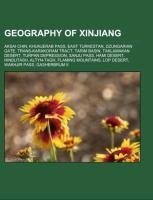
-
 Anglický jazyk
Anglický jazyk
Geography of Xinjiang
Autor: Source: Wikipedia
Source: Wikipedia. Pages: 34. Chapters: Aksai Chin, Khunjerab Pass, East Turkestan, Dzungarian Gate, Trans-Karakoram Tract, Tarim Basin, Taklamakan Desert, Turpan Depression, Sanju Pass, Hami Desert, Hindutash, Altyn-Tagh, Flaming Mountains, Lop Desert,... Viac o knihe
Na objednávku, dodanie 2-4 týždne
14.04 €
bežná cena: 15.60 €
O knihe
Source: Wikipedia. Pages: 34. Chapters: Aksai Chin, Khunjerab Pass, East Turkestan, Dzungarian Gate, Trans-Karakoram Tract, Tarim Basin, Taklamakan Desert, Turpan Depression, Sanju Pass, Hami Desert, Hindutash, Altyn-Tagh, Flaming Mountains, Lop Desert, Wakhjir Pass, Gasherbrum II, Yumen Pass, Baltoro Muztagh, Muztagh Ata, Ulugh Muztagh, Kulma Pass, Chakragil, Torugart Pass, Kongur Tagh, Qigexing Buddhist Temple Ruins, Gurbantünggüt Desert, Shipton's Arch, Skyang Kangri, Iron Gate Pass, Taghdumbash Pamir, Bedel Pass, Subashi Formation, Sauyr Zhotasy, Kumul Depression, Tarbagatai Mountains. Excerpt: The Dzungarian Gate (Chinese: ; pinyin: Ala Shankou) is a geographically and historically significant mountain pass between China and Central Asia. It has been described as the "one and only gateway in the mountain-wall which stretches from Manchuria to Afghanistan, over a distance of three thousand miles." Given its association with details in a story related by Herodotus, it has been linked to the location of legendary Hyperborea. The Dzungarian Gate is a straight valley which penetrates the Dzungarian Alatau mountain range along the border between Kazakhstan and the Xinjiang Uyghur Autonomous Region. It currently serves as a railway corridor between China and the west. Historically, it has been noted as a convenient pass suitable for riders on horseback between the western Eurasian steppe and lands further east, and for its fierce and almost constant winds. In his Histories, Herodotus relates travelers' reports of a land in the northeast where griffins guard gold and where the North Wind issues from a mountain cave. Given the parallels between Herodotus' story and modern reports, scholars such as Carl Ruck, J.D.P. Bolton and Ildikó Lehtinen have speculated on a connection between the Dzungarian Gate and the home of Boreas, the North Wind of Greek mythology. With legend describing the people who live on the other side of this home of the North Wind as a peaceful civilized people who eat grain and live by the sea, the Hyperboreans have been identified by some as the Chinese. The windswept valley of the Dzungarian Gate, 6 mi (10 km) wide at its narrowest, is located between Lake Alakol to the northwest in Kazakhstan and Ebinur Lake (Chinese: ; pinyin: Àibi Hú) to the southeast in China. At its lowest, the floor of the valley lies at about 1,500 feet (450m) elevation, while the surrounding peaks of the Dzungarian Alatau range reach about 10,000 feet (3,000m) to the northeast and 15,000 feet (4,500m) to the southwest. Douglas Carruthers, who explored the area in the f
- Vydavateľstvo: Books LLC, Reference Series
- Rok vydania: 2020
- Formát: Paperback
- Rozmer: 246 x 189 mm
- Jazyk: Anglický jazyk
- ISBN: 9781156482872







 Nemecký jazyk
Nemecký jazyk 
 Ruský jazyk
Ruský jazyk 



